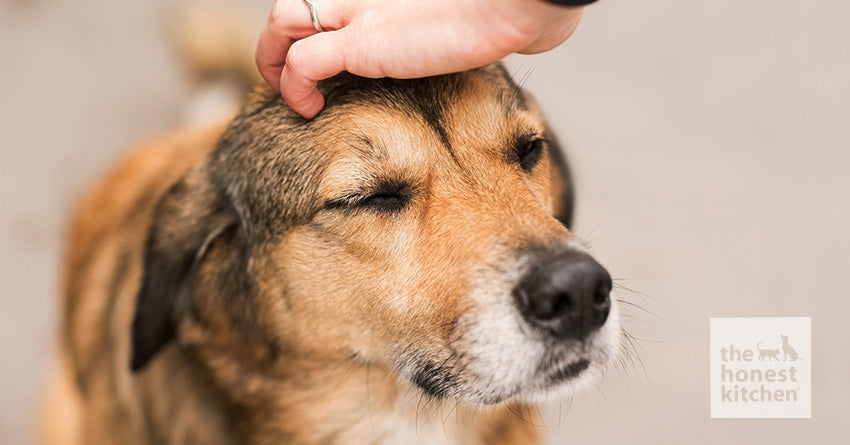There’s nothing worse than seeing your dog suffer. What makes it even harder is that your dog can’t tell you what they’re feeling, so successfully treating their illnesses can sometimes be a challenge. But it helps to know what the common issues look like so you can recognize and treat them sooner.
Today, we’re breaking down yeast infections — a common yet frustrating illness that can cause your dog discomfort. Keep reading to learn more about what may cause these infections, their symptoms, and the foods that support a healthy skin and coat!
What Is a Yeast Infection?
A canine yeast infection, also known as yeast dermatitis, is a common illness that occurs when a dog’s immune system fails to control the yeast on their skin or in their ears.
Yeast infections are a common issue that many dog owners will experience throughout their pet’s lifetime. However, you can often help prevent infections through your dog’s diet, hygiene, and activities.
How Dangerous Is a Skin Yeast Infection?
Yeast infections are not especially dangerous on their own. However, uncontrolled, they can lead to other serious health issues. When left untreated, a yeast infection can spread across your dog’s skin and even into their mouth. Yeast infections are also incredibly uncomfortable and may affect your dog’s quality of life.
Signs and Symptoms of Yeast Infections
The sooner you catch yeast problems, the easier it is to treat them. Common skin infection symptoms include:
- Hair loss
- Red, flaky, or irritated skin
- Skin sores
- Persistent scratching
- Musty smell
- Swelling of infected areas
How Do Dogs Get Yeast Infections?
All those symptoms sound pretty uncomfortable, right? Of course, you don’t want your pet to experience any of those symptoms, so knowing how dogs are likely to get skin infections is important!
Moisture and Humidity in Warmer Months
Moisture makes it easier for yeast to grow and spread, and when seasonal warm weather rolls in, it often carries high humidity with it. When that happens, your dog may be more likely to get a yeast infection, especially if moisture gets trapped in the folds of their skin or the webbing of their paws.
Skin Folds, Wrinkles, and Floppy Ears
As adorable as they can be, dog breeds with skin that hangs off their bodies and folds over itself are prone to yeast infections since it’s easy for moisture to get trapped in those skin folds.
The same can be true for floppy ears like you’ll find on a Basset Hound and the facial folds of a bulldog. Floppy ears are also likely to dip into the water when dogs drink, which increases the chances of a yeast infection inside their ears.
In fact, any part of your dog’s body with crevices and folds can sustain a yeast infection. That’s why the webbing between their toes and the skin folds around the vulva are also commonly infected areas.
Dogs That Have Atopy
Atopy, or atopic dermatitis, is also a common cause of yeast infections. Atopy is a lifelong condition with no known cure and is marked by excessive itchiness spurred by allergens in the surrounding environment.
Since yeast infections typically show up when a dog’s immune system is compromised, common allergens in the air or food allergies can set off yeast infections in dogs with atopy.
Dogs That Get Water-Soaked
When a dog loves swimming, it’s hard to keep them out of the water. But since non-chlorinated water (like you’ll find in ponds and lakes) holds bacteria, it can be the catalyst for a canine yeast infection.
You don’t have to eliminate swimming completely to avoid yeast infections, but you should always wash your dog with fresh, clean water and shampoo and thoroughly dry them off after they go for a swim.
How Are Yeast Infections Treated?
Even when you do everything right, yeast issues can still develop. When they do, it’s important to act quickly to treat your dog’s yeast infection.
Cleaning and Grooming Coat Regularly
Weekly baths with shampoo are an important habit to get into if you have a dog with yeast problems. Dogs that spend time in the water, have atopy, or have folds of skin will need regular grooming. Otherwise, ongoing infections could affect their overall health and quality of life.
Ear Flushing
Dog’s ears are especially prone to yeast infections. They’re shaped like an “L” inside, which makes it easy for liquid to get trapped and cause a yeast infection or other type of ear infection. That’s why it’s important to flush your dog’s ears anytime they’ve been in water, especially if their heads were submerged.
Ear cleaning and giving ear medication to dogs can sometimes be tough, but it’s important to make it a regular routine if your dog is prone to yeast infections. We recommend speaking with a trusted veterinarian about what may work best for your pet.
Seeing a Veterinarian or Veterinary Board-Certified Dermatologist
Even if you’re positive your dog has a yeast infection, you should still see a veterinarian or a veterinary board-certified dermatologist to get a diagnosis and treatment. There are other infections and issues that can cause the same symptoms, and your vet will run tests to make a correct diagnosis.
They’ll also provide you with treatment options that will get your dog happy and healthy as fast as possible. Remember, the longer you wait to address a yeast infection, the more problems it can cause for your dog.
Antifungal Treatments
Antifungal shampoos and/or creams will likely be a part of your dog’s road to recovery, and they must be used regularly, as directed by your vet, in order to be effective.
In more severe cases, your dog may also need an oral antifungal medication, like ketoconazole. If this is the case, make sure you inform your vet of other medications your dog is on so that there are no adverse side effects.
The Best Food Choices for Dogs With Yeast Infections
An effective way to help treat and prevent yeast infections is by feeding your dog the best dog food for their specific dietary needs.
Each dog will have different needs and tastes, but here are some of the best high-quality dog foods and treats to support a healthy coat, skin, and immune system.
Dehydrated Grain Free Fish
Fatty acids are one of the best nutrients to support your dog’s skin, and this dog food recipe is rich in omega-3 fatty acids, thanks to its main ingredient of wild caught white fish.
It’s also a grain free recipe that leaves out fillers and by-products that can cause skin issues and upset sensitive stomachs, opting instead for whole food carbohydrates like sweet potatoes and pumpkin.
Since this grain free dog food comes from The Honest Kitchen, it’s 100% human grade with ingredients you’ll recognize and your dog will love.
Dehydrated Limited Ingredient Duck
Food sensitivities are one of the main contributors to yeast infections and itchy skin. So a limited ingredient diet that is both nutritious and supports your dog’s immune system is key.
This limited ingredient duck recipe has just six quality ingredients — including lean protein from cage free duck, sweet potatoes, and flaxseed. Plus, it has no artificial preservatives, high fructose corn syrup, or artificial colors.
Dehydrated Limited Ingredient Fish
Fish oils are especially helpful in maintaining a healthy coat and skin, and this recipe from The Honest Kitchen has wild caught white fish as the first ingredient.
Even with limited ingredients, this dog food offers wholesome nutrition from natural ingredients like chickpeas, coconut, celery, spinach, and pumpkin, making it a top pick for dogs with food sensitivities.
Functional Pour Overs: Skin & Coat Salmon Stew
Already have a filler-free dry dog food that works well for your pup, but want to add a nutritious boost? The Honest Kitchen’s Pour Overs are a great choice.
This supplement specifically adds a blast of omega fatty acids from salmon, bone broth, and white fish. Plus, it has vitamins and minerals like biotin, zinc, and vitamin E to support a healthy coat and skin.
Instant Goat’s Milk With Probiotics
Digestive enzymes and probiotics support a healthy stomach, which in turn, supports a healthy immune system to help fight off yeast infections. That’s why yogurt is a great snack to support gut health in dogs.
This dehydrated additive is a great way to support your dog’s immune and digestive systems with 1.25 billion active probiotics.
What To Do If Yeast Infections Are Recurring
Even with the best pet foods available, it’s still possible for yeast overgrowth to cause an infection in your dog. Still, there are several ways you can lessen the chances of infection or break the cycle of repeat infections.
To prevent yeast infections, you need to reduce your dog’s exposure to fungal spores. They tend to gather in the carpets in your home and anywhere your dog regularly sleeps, so a good first step is to remove or clean dirty blankets, carpets, and beds.
While you’re at it, you can clean or remove all fabric surfaces that you think may be storing spores that are infecting your dog. You can also take it a step further by putting HEPA filters in your home to remove spores from the air.
If you do all those things and infections still occur, specifically in your dog’s paws, you may need to adjust their diet under the direction of your vet, as infections in paws often come from food allergies.
A novel animal protein diet uses ingredients your dog hasn’t been exposed to before and hasn't developed an allergy to. So, certain protein sources, such as duck, could reduce the amount of yeast infections they experience.
Of course, probiotics and prebiotics can be just as important for healthy digestion as the food your dog eats — plus they support immune health. So if your dog’s wet food or kibble doesn’t include probiotics, you can try mixing in a probiotic supplement for a more anti-yeast diet.
Make Healthy Food Choices for Your Pup With The Honest Kitchen
No dog owner wants to see their pup suffer from itchy skin and yeast infections. But it’s important to recognize the signs and symptoms and get your dog to the vet as soon as possible if you suspect they have a yeast infection.
If your dog is prone to yeast infections, a high-quality dog food made with skin- and coat-supporting ingredients can help. The Honest Kitchen has a wide variety of limited ingredient, human grade recipes to fit every dog’s needs and tastes.
Find your dog’s next favorite food from the Honest Kitchen now!
*Health Disclaimer: This post is educational in nature and doesn’t constitute health advice. Please consult your pet's veterinarian or other healthcare professional for specific guidance on this topic.
